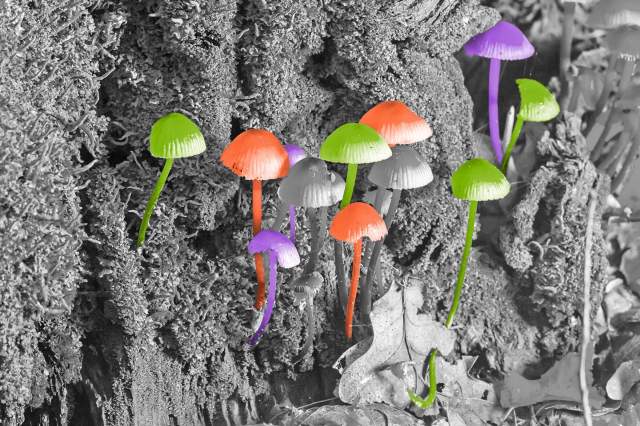
They’re More Like Humans Than Plants
For centuries, fungi were misclassified as plants — and it’s an understandable mistake to make. After all, both appear to have a stalk-like structure and otherwise look visually similar. However, fungi have more in common with animals than they do with plants. Some 1.5 billion years ago, animals and fungi separated from plants, and it wasn’t for another 10 million years that fungi and humans went their separate evolutionary ways. Using computational phylogenetics, scientists discovered that humans and fungi are actually part of the same biological clade, called an “opisthokonta,” named after a part now found in both animal sperm and fungal spores. It’s estimated that humans and fungi share roughly 50% of their DNA.

They’re Used in Some of Humanity’s Most Important Medicines
Fungi are often considered a fine delicacy, a poisonous hazard, or a hallucinogenic head trip, but they also play a vital role in medicine. The most famous fungi-based drug is penicillin, whose lifesaving properties were discovered completely by accident. In 1928, upon returning to his laboratory at St. Mary’s Hospital in London after a two-week vacation, Scottish physician Alexander Fleming found mold growing on a petri dish of Staphylococcus, a group of bacteria known to cause a variety of infections. Instead of tossing the petri dish in the trash, Fleming noticed that the mold, a fungi known as penicillium, appeared to stop the bacteria dead in its tracks. This happy accident kick-started a mission to create the world’s first antibiotic — one of the greatest medical breakthroughs of the 20th century and arguably one of the greatest in human history.

One Fungi Can Turn Ants Into Zombies
While some fungi can save lives, others can take them. Take, for instance, Ophiocordyceps unilateralis. Found in tropical forests, this fungus possesses the incredibly creepy ability to essentially take control of an ant’s body (likely via its nervous system), effectively transforming it into a zombie. Compelled by the fungus to find a humid microclimate more advantageous for the fungus’ propagation, the ant moves to a suitable spot and eventually dies, and the fungus uses its desiccated corpse to produce fruiting bodies that’ll send spores off to infect more ants — and the cycle continues. This specific fungus inspired the hit video game and television series The Last of Us, which follows a society in collapse as humans become mindless zombies in service of this bizarre fungus. Thankfully, in reality, human bodies are far too warm and complex for Ophiocordyceps unilateralis to have any mind-altering effect.
More Interesting Reads

A Fungus in Oregon Is the World’s Largest Organism
Located in the Malheur National Forest in Oregon and known affectionately as “the Humongous Fungus,” Armillaria ostoyae is the largest known organism in the world by biomass. Stretching 2,385 acres (about the size of the Mall of America), this fungus (and its interconnected mycelia) is located mostly underground — in fact, hikers could walk on it and not even notice.
Scientists discovered this massive fungus (also known as the honey mushroom, in reference to its honey-colored cap) in 1998, but estimates suggest that the fungus has been lurking in the forest for around 10,000 years. Its location underground likely aids its longevity; scientists theorize that being cut off from the sun’s rays limits genetic mutations over millennia. The fungus isn’t great news for trees in the vicinity, since it often kills them, but the forest’s constant regeneration keeps the hungry fungus alive.

There are 80 Types of Fungi on the Heel of Your Foot
It’s easy to picture fungi as simple fruiting bodies popping out of dense, debris-littered forest floors, but microscopic fungi are literally everywhere — in the water you drink, the air you breathe, and yes, even on your body. Scientists in 2013 analyzed “hot spots” of the human body ripe for fungal growth (think palms, feet, etc.), and found that the heel is host to at least 80 different types of fungi. The rest of the foot doesn’t fare much better, with 60 types found in toenail clippings and 40 found between toes.
Not all fungi are harmful to humans, but around half of them are, which is why feet are common victims of fungal infections such as athlete’s foot. But although some fungi can be a health risk, other microscopic fungi are what make life worth living — they serve as the biological engine behind such delicacies as bread, cheese, wine, and beer.

90% of Fungi Is Unknown to Science
As recently as the 1960s, scientists still considered fungi to be plants, so it’s probably not surprising that there are a few more mysteries to uncover within this expansive kingdom. But finding the answers to those mysteries can be daunting, because scientists only know about 10% of the estimated 3.8 million species of fungi in the world. And yet fungal existence underpins the natural world itself: Fungi serve as vital decomposers, especially in the world’s forests and jungles. Today, fungi are being used for making new biofuels and breaking down plastics —and in some cases, even replacing plastics entirely. Fungus is truly among us, and it’s a very good thing that it is.











